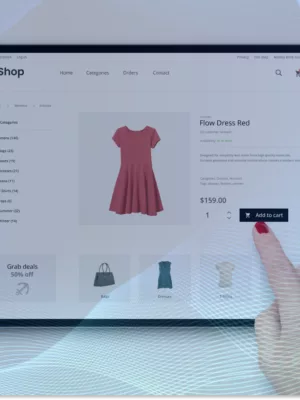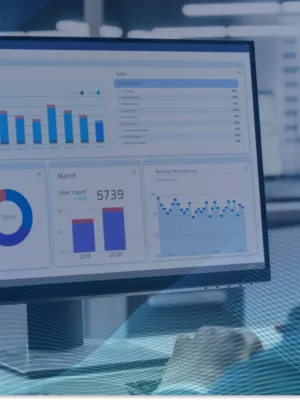
Cloud computing, for all its benefits, is often equated with a higher security risk than, say, if you were to host your own server on-site. But cloud computing and storage is like anything else you do on the web. Set and follow strict security practices and work with trusted vendors who prioritize security, and you’ll be okay. This guide will show you how Microsoft Azure will help you fend off even the nastiest of security risks.
The benefits of moving to the cloud are overwhelming. You gain so much while simultaneously getting rid of things you don’t need or shouldn’t have ownership of (like costly server equipment).
But are the performance benefits and cost savings worth it? Or is it too risky to move your business to the cloud?
There are certain security risks associated with migrating to the cloud. And it can cost you, too: in time, money, clients, or reputation.
So, what do you do? Shy away from the cloud and all the benefits that come with it for fear that moving to the cloud is too risky? Of course not. Just because cybersecurity is a major concern for many cloud users, that doesn’t need to be the case for you.
Today, we’re going to examine the most common and disastrous security risks associated with the cloud. Then, we’re going to look at what Microsoft Azure is doing to keep your assets safe and why it’s the only cloud computing program we’re willing to stand behind to host, build, and manage our clients’ assets.
What Microsoft Azure is doing to prevent security breaches in the cloud
We know how important cybersecurity is, especially when you’re entrusting your assets to the cloud, and how devastating it can be when that security and trust gets broken.
It’s safe to say that you expect your cloud computing provider to keep your data and assets safe. Unfortunately, that’s not always a given.
Microsoft Azure is different though. Not only is it the pinnacle of excellence when it comes to hosting your digital assets, it’s the best when it comes to cloud security, too. That’s Reason #1 why we’d never consider using any other cloud provider for ourselves or our clients.
Your data is just too valuable to put into the hands of anyone else.
So, just how good is Microsoft Azure when it comes to securing your digital assets? Let’s break down how they address the most common cloud security risks.
Risk #1: Data loss

Whenever you move data or digital assets (like your website or app) from one place to another, there’s a risk of something getting lost in transit. Heck, data loss can occur even when it remains sitting on your server. That said, without a reliable backup and restoration service in place, that risk could realistically become a reality without the right safety net.
How Azure prevents data loss
You want to know that when your data moves from an on-premise solution to the cloud, that nothing’s going to get lost between Point A and Point B. The same goes for storing your data in the cloud.
Without total control over your infrastructure, this can easily become a nerve-wracking experience. But with Microsoft Azure, you’re covered from both the backup and restore perspective — essential pieces of any good disaster recovery and business continuity plan.
Backups
Azure Backup services save your data to the cloud while also adding an extra layer of protection against ransomware. The beauty of this service is that it’s easy to control, too. In just one click you can capture a backup of all your assets.
Restore
The other half of that equation is the Azure Disaster Recovery Service. In order to ensure that you don’t lose any data, this DR service duplicates your backups across various servers, virtual and on-premise. This way, in the case of data or backup loss, it can quickly be restored from a safe recovery point.
Project Cerberus
In sum, Project Cerberus is Microsoft’s all-in-one firmware security protocol. This microcontroller monitors Azure’s hardware and firmware for vulnerabilities and bugs. When threats are detected, the issues are dealt with before you even have a chance to notice an issue on your end.
Migration
And if you’re still nervous about protecting your data during the migration security piece, don’t be. Convergine as your cloud services provider can safely handle the migration for you.
Risk #2: Insecure infrastructure

Moving to the cloud, you have to accept that you’re going to relinquish some control over your assets. Of course, if you use a cloud computing platform that doesn’t prioritize security, you could be handing over more than just control to your hosting provider. You could be handing over access to hackers if their servers aren’t properly secured or maintained.
How Azure secures its infrastructure
Microsoft estimates that it spends over $1 billion each year on security, which includes fortifications to the Azure platform. Not only does this ensure that its physical and virtual servers are secure, but it provides a safe environment for your data.
Security experts
One of the ways Microsoft makes this possible is by employing over 3,500 cybersecurity experts. These security pros are available 24 hours, 7 days a week, 365 days a year to ensure that Microsoft’s infrastructure remains intact and, by proxy, your digital assets are protected.
But this isn’t just about continually securing Microsoft’s hardware and software. This is also about watching for and identifying potential vulnerabilities. The more time they spend doing this, the stronger the team’s documentation and processes become so they’re even more efficient at handling server-side security issues.
Isolation
When your data is stored on a Microsoft Azure server, you’re actually sharing space with other companies who’ve stored their assets there. For some platforms, that would be a cause of concern as poor security practices exhibited by a neighboring organization could negatively impact your own security.
However, with Azure, your data is always segregated from others’ data and kept secure from outside vulnerabilities. Microsoft even keeps its own networks separate from its customers — something that’s good not just for security, but also for performance, too. This way, if a hacker tries to go after Microsoft, it can’t simultaneously get at you.
100% under Microsoft control
Microsoft isn’t outsourcing your or their security to others. It handles everything related to its security, including:
- Network cabling
- Security equipment
- Network monitoring
- User authorization and access rules
It even dictates which devices and administrators are allowed to get inside of Azure to ensure that everyone touching the cloud is meant to be there.
Risk #3: Human error

In some cases, it’s not the cloud provider’s fault when a security breach happens. As humans, we make mistakes, too. Poor security practices like logging in through unsecured devices, using weak passwords, and visiting untrustworthy sites can put your cloud-based data at risk. What’s more, even errors introduced into code can wreak havoc, creating bugs that pave the way for hackers to get in.
How Azure helps you cut down on human error
While Microsoft is working hard to lock down its infrastructure, it’s up to you to do the same for your assets. Don’t fret though. Azure has given you the controls needed to protect your assets from human error.
Cloud access control
It doesn’t matter what role you play in your organization. You’re going to be logging into dozens, if not hundreds, of apps every month. All it takes is one less-than-secure set of login credentials to open the door to the rest of your network.
Azure Active Directory helps you better control access to your apps. This goes beyond what you use in Azure, too. You can use this to secure access to Google, Box, Office 365, and many more cloud and on-premise apps.
Role-based access control
It’s not safe to assume that your team will follow your security protocols, even if you spell them out clearly. So, what you need to do is restrict who can do what and where within your network.
You can use the Role-Based Access Control feature to do this.
This enables you to create roles for your team and assign specific rights to each role. This way, you prevent unfettered access from putting your data at risk.
Another thing you can do to limit how much impact users have on your cloud is by restricting how they connect to it. Specifically, you can block certain devices or unknown networks to ensure that they’re always following best practices when logging in.
By that same token, you might want to give them a more secure way to log into the network even when they’re not working over a private line. With Azure ExpressRoute, you and your team can easily and securely establish a connection between your on-premise devices and the cloud.
Shared access control
Let’s say you want to give someone else access to your Azure storage account. You could create a custom role for them, but a better option is to create a shared access signature. This allows you to give them access to certain objects in your account, for a set period of time, and with specific permissions.
Risk #4: Weak authentication and encryption

It’s not just hackable passwords that put your cloud security at risk. It’s weak authentication and data encryption, too. So, rather than rely on a single layer of protection to mask your logins and in-network activity, you’re going to need to amp up your encryption and authentication efforts.
How Azure strengthens authentication and encryption
Without authentication and encryption, you might as well lay out the welcome mat for hackers. You need these security protocols to protect your secrets, which is why it’s good to know that Azure isn’t in short supply of them.
Authentication
The login of any app always poses a big security risk. If the login screen is easy to find, that’s your first problem. Then, there’s the matter of password strength. And, if those two fail to keep hackers out, a lack of authentication certainly will.
Microsoft goes above and beyond the basic two-factor authentication approaches used by other cloud providers. Instead, it uses multi-factor authentication, asking users for at least two of the following identifiers:
- Something you know, like your username and password.
- Something you own, like your phone number or email address.
- Something that’s a part of you, like your fingerprint.
This makes it near-impossible for hackers to break in this way.
Encryption
Encryption is the process that protects your data whether it’s at rest, in use, or in transit. Thankfully, Azure has built encryption into its services. That said, it does still ask users to strengthen it even further.
For instance, if you use an Azure Virtual Network (basically, a VPN) or ExpressRoute, you’re responsible for encrypting those networks since they’re not under Azure’s jurisdiction.
It’s also your responsibility to use the Azure Key Vault to create and update your cryptographic keys and secrets. There’s little work you need to do. It’s simply a matter of setting it up.
Risk #5: Missing security measures

There are many ways hackers can get into your cloud, which is why it’s never enough to lock just one door. Your hardware, software, and even your personal devices need to be locked up tight and access restricted. It’s the only way to keep distributed denial of service (DDoS) attacks, malware injections, data breaches, and other hijacking and defacing attempts at bay.
How Azure covers all essential security and compliance measures
Even with all of the security measures mentioned above, hackers can still find areas of your cloud to exploit. That’s why you should let Microsoft Azure take your server-side security to the next level.
Don’t forget about the governing and standards bodies who want to ensure you’ve built products the right way and are delivering them securely to your users. Azure rounds out its security offering with compliance, too.
Security
There’s so much Azure does that we’re going to give you just a quick rundown of some of the additional security features you should take advantage:
- Web Application Firewall - automatically built into Azure’s servers
- Azure DDoS Protection - monitors the network and scrubs out malicious traffic before it can impact your assets
- Mi-crosoft Antimalware for Azure Cloud Services and Virtual Machines you have a choice of which antimalware vendor you use: Kaspersky, Microsoft, McAfee, Symantec, or Trend Micro
- Azure Security Center - alerts you to issues on your network and even in your private, virtual environments
- Azure Monitor - keep an eye on performance issues within your network in real-time
- Tinfoil Security - this web vulnerability scanner monitors your apps for vulnerabilities
As you can see, Microsoft Azure takes security seriously, not only mitigating security risks, but also actively monitoring for them so you know in real-time when threats arise.
Compliance
It doesn’t matter what kind of product you build in the cloud. Governments and regulators aren’t going to look too kindly on it if it’s not in compliance with their regulations. For instance:
- GDPR is fairly standard these days as most websites and apps come in contact with EU residents.
- WCAG 2.0, which deals inaccessibility, is another important one for many products.
- Then, there are the more specialized certifications you might. Some are industry-specific (like ISO certifications) while others are specific to locations (like the TISAX in Germany).
Rather than stress over how you’re going to build a compliant product — and to do so when your product is regulated by so many standards bodies — Microsoft Azure helps with this, too.
Azure has over 90 compliance offerings to choose from. In addition to providing you with a datasheet that explains the specific regulation in detail, Azure also provides you with useful information on how to adhere to the standard in full. In some cases, Azure has taken care of those security and privacy controls server-side, but there is likely to be work you have to do on your end to become fully compliant.
Once you’ve fully implemented everything, though, you’ll receive your certification.
Add Convergine to your cloud security plan
Now that you know where the most common security risks come from in the cloud and what Microsoft Azure is doing to keep them away from your assets, what’s next?
Well, it’s important to recognize that Microsoft will only be able to go so far with helping you secure your data and assets. When it comes to server-side security, it’s got you covered. As for securing your website and apps, though, you’re going to need help.
With Convergine as your cloud services provider, that problem is solved. Not only do we know how to build your assets and configure your software, we’re in the best position to manage and monitor them for security issues.
If you’d like to talk to us about how we can fill in the missing security piece and help you put all of these Azure security protocols into place, get in touch today.










